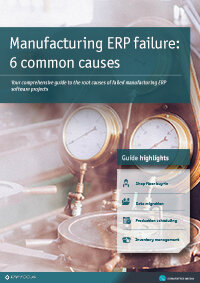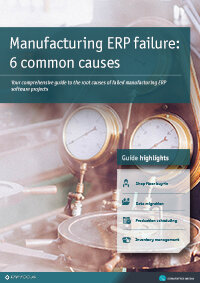ERP and TOC can work together to optimize your supply chain
Goldratt's Theory of Constraints (TOC) is usually thought of when considering equipment or labor as the constraining factor limiting output. However, the supply chain can also act as the constraint. You might have a single supplier whose capacity to deliver what you need is limited. It is important to quickly recognize this situation and use the drum–buffer–rope technique to optimize your supply chain and your ERP to optimize the process.
Finding the drumbeat
If your supplier is your constraint, then every action and decision will be subservient to that constraint. Use your manufacturing ERP to identify the maximum rate of production they are capable of. That rate is your drumbeat. Your own internal processes may go faster. Other suppliers may go faster. It doesn't make any difference; whatever rate that supplier is capable of, that is your limit and making other operations run faster only builds inventory.
Establishing your buffer
Once the drum rate is understood, begin to establish buffers ahead of your constraint. A buffer could be inventory or help with raw materials so your supplier never runs out of any necessary inventory and can keep producing. The buffer could be working capital to help ensure production never falls below the drum rate.
Recommended reading: manufacturing ERP - 10 steps to success
Transportation is another common supply chain constraint. We have all seen images of the giant crawler vehicles that moved the space shuttle to its launch platform. The movement is in meters, not miles, per hour. A buffer here might be space. Anything that brings the starting and finishing points closer together will help your cause.
Tying the rope
The final element in the TOC process is the rope. Link your processes together so that none of them move faster than the constraint on the upstream side. Think of the rope as a limit on other processes and suppliers that ties them to the constraint's drum rate. Avoid bringing in component materials from other suppliers ahead of the constraint, since they cannot be used yet. Similarly, starting work on another subassembly in house that will not be used until the constrained material is available will add no value and may cost you.
Thoughtful use of ERP will coordinate supply chain components with your constraints wherever you find them.
Your manufacturing ERP should contain the expected lead times for all material parts. The requested date and quantity should also be recorded in your ERP system. As purchase orders progress, those requested dates and quantities will be supplanted by promised dates and quantities and the ASN should be the final data element for planning. Thoughtful use of ERP will coordinate supply chain components with your constraints wherever you find them. You already have the tools you need, now start using them to optimize your constrained supply chain the TOC way.
Free white paper

Manufacturing ERP Failure: 6 Common Causes
Get your comprehensive guide to the causes of manufacturing ERP failure

Related articles
-

How to use ERP workflow to improve supply chain management
Learn how automated ERP workflows can improve order management, production scheduling and more su...
-

Secret KPI: Why Your ERP Implementation Team Matters More Than Software
Learn how Godlan ensures successful ERP implementation for manufacturers with proven strategies &...
-

ERP & Logistics: Optimizing the Supply Chain
Read about the steps you can take to optimize your supply chain through ERP software logistics ma...

